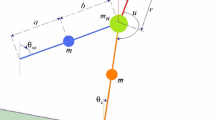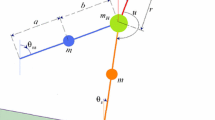Abstract
Dynamic analysis of passive biped models plays a significant role both in understanding human locomotion and in developing humanoid robots. In this investigation, two chaos control algorithms based on linearization of Poincaré map (OGY method) and artificial neural networks (ANNs) are utilized to control the motion of a passive biped model. To this end, the chaotic characteristics of the system are analyzed using several nonlinear dynamics tools such as Poincaré map, bifurcation diagram, and Lyapunov exponents, and then, unstable periodic orbits (UPOs) of the system are detected. Detection of these orbits helps to extract a desired walking pattern and also is utilized for chaos elimination of the system. The robustness of the proposed ANN-based control algorithm is verified by applying toe-off impulses to the biped during the gait. Furthermore, the effect of network parameters on the biped walking performance is investigated to get design guidelines for the ANN-based controller.








Similar content being viewed by others
References
Abedini M, Vatankhah R, Assadian N (2012) Stabilizing chaotic system on periodic orbits using multi-interval and modern optimal control strategies. Commun Nonlinear Sci Numer Simul 17(10):3832–3842
Alberto L, O’Connor JJ, Giannini S (2014) Biomechanics of the natural, arthritic, and replaced human ankle joint. J Foot Ankle Res 7(1):8
Asano F, Toshiaki S, Tetsuro F (2015) Passive dynamic walking of compass-like biped robot on slippery downhill. In: IEEE/RSJ international conference on intelligent robots and systems (IROS) 2015
Baker GL, Gollub JP (1996) chaotic dynamics. Cambridge University Press, NewYork
Bu S, Wang BH, Jiang PQ (2004) Detecting unstable periodic orbits in chaotic systems by using an efficient algorithm. Chaos Solitons Fractals 22:237–241
Buhl M, Kennel MB (2007) Globally enumerating unstable periodic orbit theory for observed data using symbolic dynamics. Chaos Interdiscip J Nonlinear Sci 17:033102
Danca MF, Tang WK, Wang Q, Chen QG (2013) Suppressing chaos in fractional-order systems by periodic perturbations on system variables. Eur Phys J B 86(3):1–8
Gan CB, Ding CT, Yang S (2014) Dynamical analysis and performance evaluation of a biped robot under multi-source random disturbances. Acta Mech Sin 30(6):983–994
Garcia M, Chatterjee A, Ruina A, Coleman M (1997) The simplest walking model: stability, and scaling. ASME J Biomech Eng 120:281–288
Garcia E, Estremera J, Gonzales de Santos P (2002) A comparative study of stability margins for walking machines. Robotica 20:595–606
Goswami A, Thuilot B, Espiau B (1998) A study of the passive gait of a compass-like biped robot: symmetry and chaos. Int J Robot Res 17(12):1282–1301
Gritli H, Khraeif N, Belghith S (2012) Period-three route to chaos induced by a cyclic-fold bifurcation in passive dynamic walking of a compass-gait biped robot. Commun Nonlinear Sci Numer Simul 17(11):4356–4372
Gritli H, Belghith S, Khraief N (2015) OGY-based control of chaos in semi-passive dynamic walking of a torso-driven biped robot. Nonlinear Dyn 79(2):1363–1384
Hagan MT, Howard BD, Beale MH (2002) Neural network design. Pws Pub, Boston
Harata Y, Asano F, Taji K, Uno Y (2012) Efficient parametric excitation walking with delayed feedback control. Nonlinear Dyn 67(2):1327–1335
Hausdorff JM, Lertratanakul A, Cudkowicz ME, Peterson AL, Kaliton D, Goldberger AL (2000) Dynamic markers of altered gait rhythm in amyotrophic lateral sclerosis. J Appl Physiol 88:2045–2053
Khosravi B, Yurkovich S, Hemami H (1987) Control of a four link biped in a back somersault maneuver. IEEE Trans Syst Man Cybern 17(2):303–325
Kurz MJ, Stergiou N (2005) An artificial neural network that utilizes hip joint actuations to control bifurcations and chaos in a passive dynamic bipedal walking model. Biol Cybern 93:213–221
Li Z, Ge SS (2013) Adaptive robust controls of biped robots. IET Control Theory Appl 7(2):161–175
Liu C, Atkeson CG, Su J (2013) Biped walking control using a trajectory library. Robotica 31(2):311–322
McGeer T (1990) Passive dynamic walking. Int J Robot Res 9:62–82
Ott E (1990) Controlling chaos. Phys Rev Lett 64(11):1196–1199
Philippe D, Drigeard C, Gjini L, Dal Maso F, Zanone PG (2013) Effects of foot orthoses on the temporal pattern of muscular activity during walking. Clin Biomech 28(7):820–824
Piiroinen P, Dankowicz H (2002) Low-cost control of repetitive gait in passive bipedal walkers. Int J Bifurc Chaos 15:1959–1973
Pourtakdoust SH, Fazelzadeh SA (2003) Effect of structural damping on chaotic behavior of nonlinear panel flutter. Iran J Sci Technol Trans B Eng 27(3):453–467
Schwab AL, Wisse M (2001) Basin of attraction of the simplest walking model. Proc ASME Des Eng Tech Conf 6:531–539
Shirazi KH, Ghafari SM (2003) Local bifurcation in torque free rigid body motion. Iran J Sci Technol Trans B Eng 27(3):493–506
Sprott JC, Sprott JC (2003) Chaos and time-series analysis, vol 69. Oxford University Press, Oxford
Starrett J, Tagg R (1995) Control of a chaotic parametrically driven pendulum. Phys Rev Lett 74(11):1974–1977
Suzuki S, Furuta K, Hatakeyama S (2005) Passive walking towards running. Math Comput Model Dyn Syst 11(4):371–395
Wang Y, Ding J, Xiao X (2015) Periodic stability for 2-D biped dynamic walking on compliant ground. In: Liu H, Kubota N, Zhu X, Dillmann R, Zhou D (eds) Intelligent robotics and applications. Springer, Switzerland, pp 369–380
Author information
Authors and Affiliations
Corresponding author
Rights and permissions
About this article
Cite this article
Taghvaei, S., Vatankhah, R. Detection of Unstable Periodic Orbits and Chaos Control in a Passive Biped Model. Iran J Sci Technol Trans Mech Eng 40, 303–313 (2016). https://doi.org/10.1007/s40997-016-0041-5
Received:
Accepted:
Published:
Issue Date:
DOI: https://doi.org/10.1007/s40997-016-0041-5




